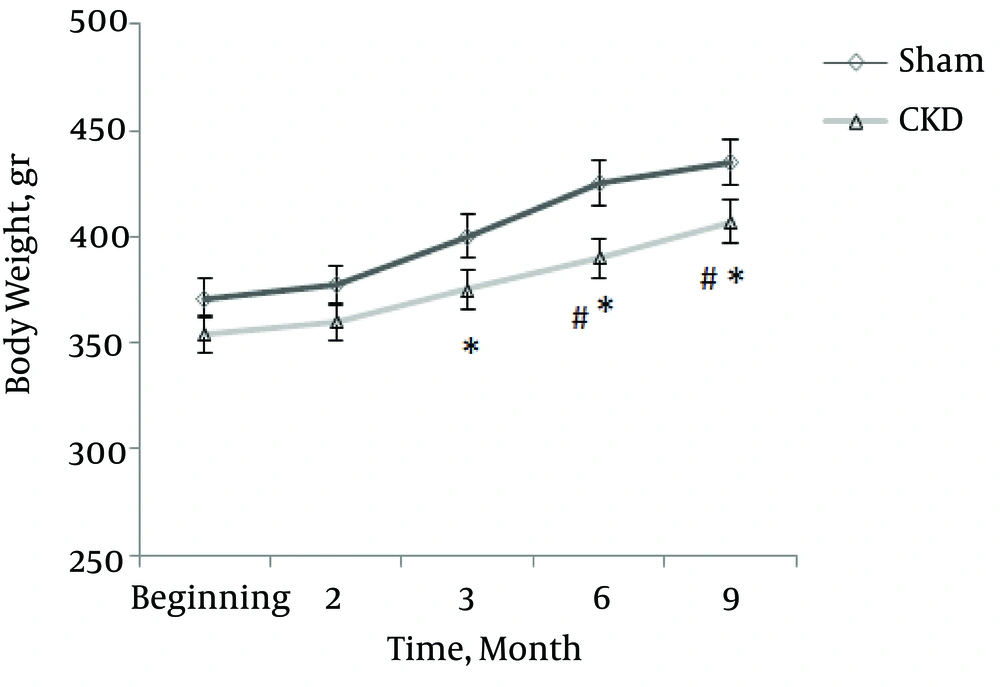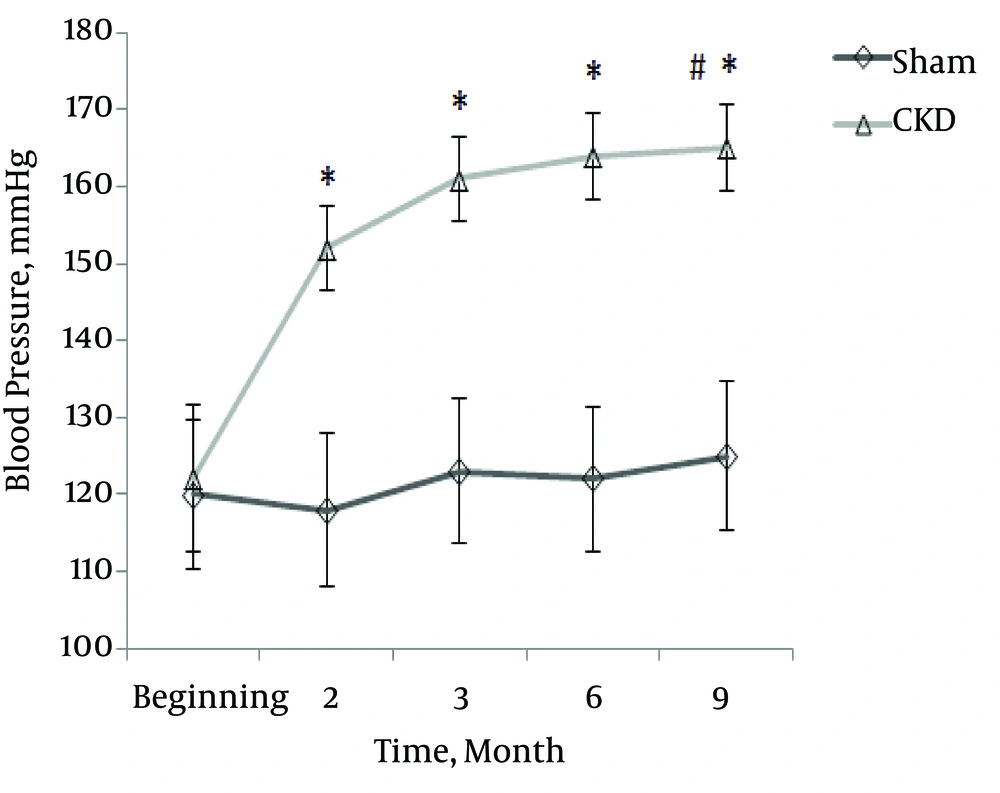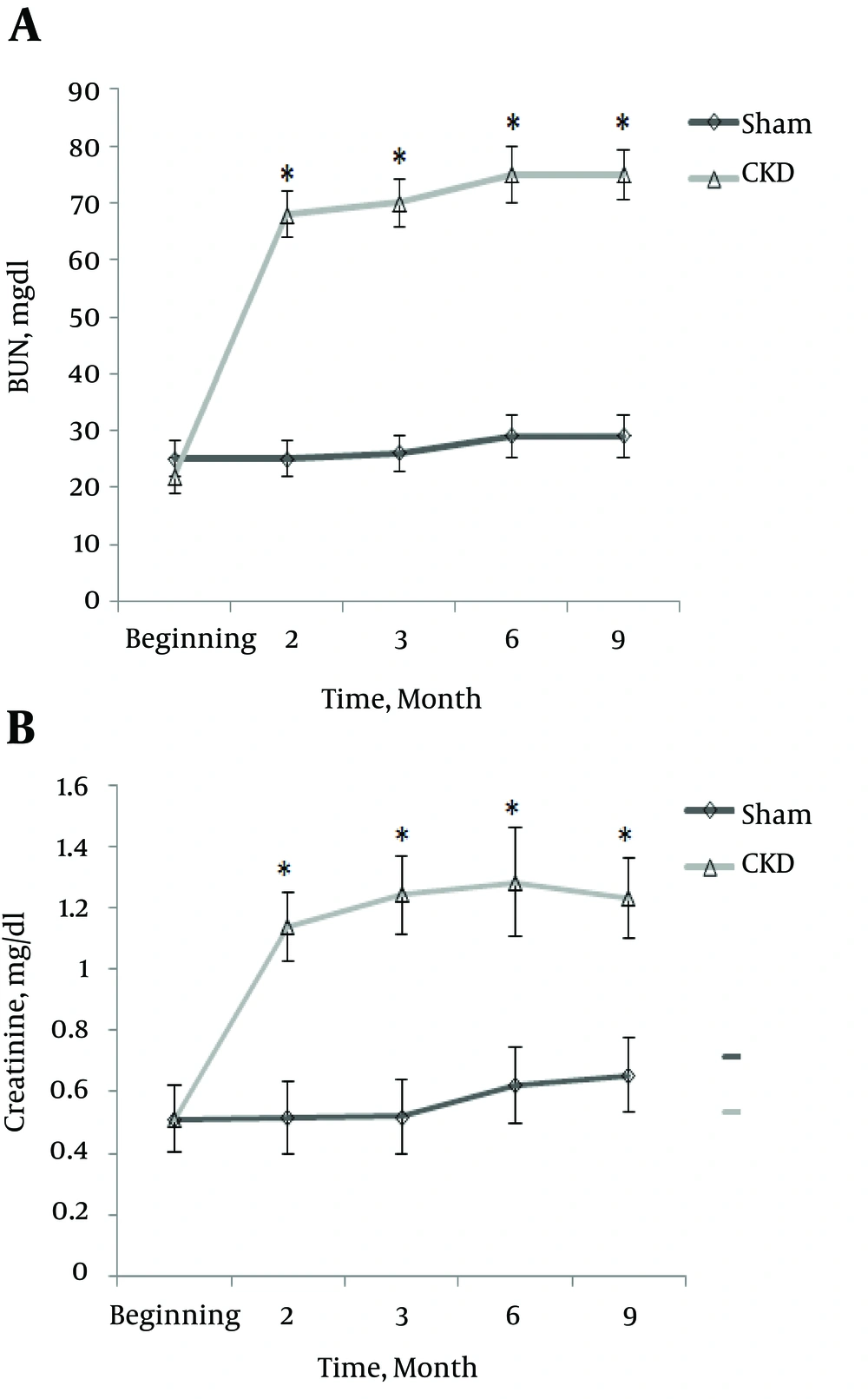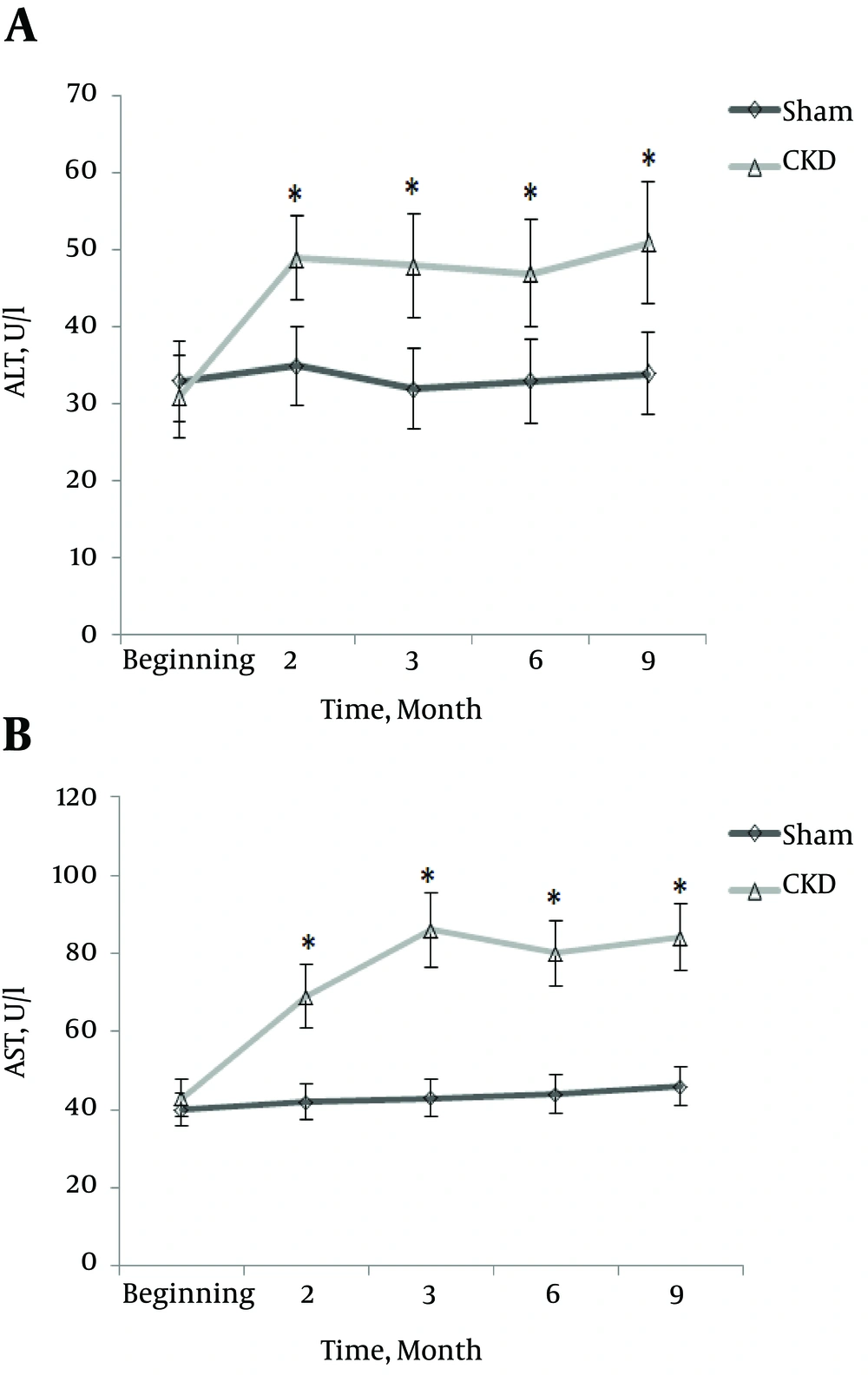1. Background
Many American adults are suffering from chronic kidney disease (CKD). CKD is a substantial public health challenge (1), with the annual direct medical costs approaching $23 billion (2). Given its high prevalence and association with adverse outcomes including loss of kidney function, which sometimes leads to kidney failure, and other complications of reduced kidney function such as hypertension, anemia, malnutrition, neuropathy, and reduced quality of life as well as increased risk of cardiovascular disease and mortality (1, 3), it is clear that CKD has widespread effects. CKD is defined as an estimated glomerular filtration rate (GFR) lower than 60 mL/min per 1.73 m2, or by the presence of markers of kidney damage (such as albuminuria or abnormal imaging studies) for three months or more. The CKD incidence rate is currently as high as 200 cases per million per year, and several population-based studies have found that CKD is much more common than previously recognized (3) as the mortality rates remain above 20 percent per year with the use of dialysis, and with more than half of the deaths related to cardiovascular disease (2). A variety of etiologies (including genetic, autoimmune, infectious, environmental, dietary, and medications) contribute to the diverse primary outcomes, but all can eventually lead to the same endpoint of CKD (4). Understanding the pathophysiological mechanisms of kidney dysfunction is therefore of fundamental importance for finding new and effective treatments for patients afflicted with renal disease (5). Animal models of CKD provide the opportunity to investigate disease-specific mechanisms and molecular pathogenesis, and to assess potential novel therapies (4). An experimental model of 5/6 nephrectomy, or the remnant kidney model, represents one of the most widely-used animal models which mimics the progressive course of renal failure after loss of renal mass and nephron numbers in humans (4, 6).
Some factors are associated with the progression of kidney disease, and in particular, hypertension is one such factor. Blood pressure control is essential to slow the progression of nephropathy in patients who are at risk of developing or have already developed CKD (7). The GFR is a more accurate way to measure how well the kidneys filter waste from the blood. The use of serum creatinine (Cr) and blood urea nitrogen (BUN) levels as indicators for GFR can help to define kidney disease, as the rate of increase or the trend of serum Cr and BUN levels can indicate the presence of CKD (2, 8).
It has been reported that the levels of serum aminotransferases (ALT and AST) commonly fall near the lower end of the range of normal values in patients with CKD. Thus, recognition of liver damage in CKD patients poses a significant challenge and is hampered by the reduction in aminotransferases leading to an underestimation of the disease load (9).
2. Objectives
The aim of the present study was to investigate the effects of CKD on renal and liver function, blood pressure, and survival rates in 5/6 nephrectomized rats.
3. Materials and Methods
These experiments were approved by the university committee for experiments on laboratory animals (Tehran University of Medical Sciences, Iran). Twenty male Wistar rats (250 - 300 g; Tehran, Iran) were randomly assigned to two experimental groups: those undergoing 5/6 nephrectomies (5/6 Nx) and those undergoing sham operations (sham). All operations were performed under total anesthesia by intra-peritoneal injection of a mixture of xylazine (10 mg/Kg) and ketamine (50 mg/Kg). Animals were housed according to the institutional guidelines for animal research, in constant room temperature under a 12-hour light/dark cycle with controlled humidity, as well as being provided with standard rat chow and water ad libitum. An adaptation period of one week was allowed prior to performing the surgical procedures.
Nephrectomy was performed following standard operating procedures. First, the left kidney was exposed through a lateral dorsal incision and decapsulated. Then, both the upper and lower poles (2/3 of the functional kidney mass) were resected. To obtain hemostasis, the excision sites were covered with sponges, and manual pressure was applied for minutes. Eventually, the vessel and the renal stump were returned into the abdominal cavity. Four days later, the total right nephrectomy was performed through lateral dorsal incision to achieve 5/6 reduction of the total renal mass. The sham operation in the control rats consisted of renal evacuation, and bilaterally returning the intact kidney into the abdominal cavity (10, 11). Strict aseptic rules were respected and special care was taken to prevent damage to the adrenal glands during the operations. The incisions were sutured in two layers and covered by a liquid bandage. After each operation, rats were treated with a one time application of ampicillin (250 mg/mL) via subcutaneous injection (12, 13) and housed individually with free access to food and water.
Body weight, renal parameters, AST levels, and ALT levels were measured at the beginning and at two, three, six, and nine months after surgery. Blood samples were collected from the tail veins of the rats. Levels of BUN and Cr in the serum were evaluated as renal parameters using an automatic analyzer (Hitachi, Ltd., Tokyo, Japan). Additionally, blood samples were taken to assess the serum levels of AST and ALT. Blood pressure was recorded in conscious animals at the same points of time after the operations. The values of systolic blood pressure were measured by the tail-cuff method connected to a pulse transducer device (MLT125/R; AD Instruments, Castle Hill, NSW, Australia). The transducer was connected to a PowerLab/4SP data-acquisition system (Chart, version 5; AD Instruments). Blood pressure was measured between 13:00 and 16:00 hours. Five measurements were taken for each rat and subsequently averaged.
3.1. Ethical Issues
The research followed the tenets of the declaration of Helsinki; informed consent was obtained, and the research was approved by the ethical committee of Tehran University of Medical Sciences.
3.2. Statistical Analysis
Results were expressed as means ± standard error of the mean (SEM). Statistical differences were tested by two-way analysis of variance (ANOVA) followed by a post hoc Tukey’s test. The level of significance was set at P < 0.05.
4. Results
Mortality during the study was as expected. Our results for survival rates showed that in the 5/6 Nx group, three rats died due to surgery-related complications after the nephrectomies or operative procedures and could not be included in the remainder of the study. However, there was no mortality in the sham group.
As shown in Figure 1, the body weight of the animals in the 5/6 Nx group did not increase in a similar way to the corresponding values of the sham group. Furthermore, evaluation of the CKD effects on blood pressure (Figure 2) showed that hypertension was developed (P < 0.05) when analyzed for time lapses. The effects of CKD on serum levels of BUN and Cr are shown in Figure 3, and the serum levels of BUN and Cr increased after induction of CKD (P < 0.05). Finally, Figure 4 shows the effects of CKD on serum levels of ALT and AST. As shown, there was a significant increase in ALT and AST levels in the CKD group as compared with the sham group based on the progression of time (P < 0.05).
5. Discussion
Chronic kidney disease (CKD) refers to the myriad problems that follow the loss of kidney function. CKD has two characteristics. First, there is chronicity because the kidney damage of CKD is rarely repaired and a continuous loss of function persists, unlike the course of acute kidney failure. Second, the loss of kidney function generates even more kidney damage, such that CKD slowly gets worse over months or even years. Initially described in 1932, 5/6 nephrectomy reduces the effective mass of the kidneys and is commonly used on animal models in preclinical studies evaluating CKD (14). Of the eight rats initially included in our 5/6 Nx group, three died. It seems that this morbidity could be related to the surgical procedure itself or to the greater severity of renal disease. Based on these considerations, we should take into account that for the 5/6 Nx model, such losses naturally occur, and it is therefore better to increase the number of animals used for this kind of study.
Our results indicated that the weight of the CKD rats did not increase in the same way as it did for the rats in the sham group when both were given free access to food, and the decline in renal function was associated with hypertension. The existence of hypertension after CKD can contribute to the development of cardiovascular disease, the leading cause of morbidity and mortality in CKD patients. In some studies, it has been observed that a salt-rich diet causes expanded extracellular volume, and a decreased capacity for excretion of sodium can lead to hypertension (15, 16). In contrast to the slowly progressive ischemic pathogenesis of nephron loss in benign nephrosclerosis, the pre-glomerular vasodilation present in CKD allows for a greater fractional transmission of systemic blood pressure to the glomeruli with resultant barotrauma. Vasodilation alone with preserved auto-regulation and uni-nephrectomy only modestly increases the susceptibility to hypertensive injury. However, with greater reduction in functional renal mass, auto-regulation is impaired, and even modest increases in blood pressure are transmitted to the glomerular capillaries (17, 18). In this regard, it seems that the increase of blood pressure is related to vascular constriction, which may be a result of the activation of the renin-angiotensin-aldosterone (RAA) system and the sympathetic nervous system (19, 20). Thus, the close association between CKD and hypertension and the damaging effects of hypertension are the reasons why people with persistent hypertension should be followed up on annually for evidence of kidney damage.
BUN and Cr are just two among a very large group of waste products that begin to accumulate when the kidneys can no longer purge them from the body. As well as being useful as amino acids to build body protein stores, they can also contribute to the production of urea. The production of urea, however, is directly proportional to the production of other waste products because urea is the principal end product of protein metabolism (21, 22). Our results showed that the serum levels of BUN and Cr increased in the CKD group as compared with the corresponding rates among the sham subjects, and evidence of nephrotoxicity was indicated by the remaining increase of serum Cr and BUN in the CKD animals. The consequence of accumulating such uremic toxins includes involving several organs such as those in the nervous and gastrointestinal systems; therefore, the production of urea should be kept to a minimum that is consistent with maintaining healthy body protein stores.
Our study showed that serum AST and ALT levels were significantly higher in CKD animals compared to the levels of the sham group. These results conflict with the results of the other studies which showed lower AST and ALT levels in the CKD subjects (23-27). These increases in serum AST and ALT levels in the present study may be due in part to the absence of renal excretion and to the frequent presence of multiple comorbid conditions.
5.1. Conclusion
Finally, this study supports the notion that CKD induced by the 5/6 Nx model caused changes in blood pressure, serum levels of Cr and BUN, as well as ALT and AST levels. These changes are sustained by the progress of time and may cause a positive feedback loop that impairs homeostasis.



